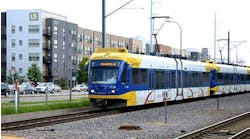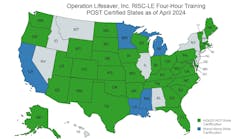New York Gov. Andrew M. Cuomo on Sept. 3, announced that MTA New York City Transit has received two Federal Transit Administration grants totaling $57,141,634 for two major storm resiliency projects in subway stations: a new emergency communications system and a hardening project to protect station rooms that are critical to service delivery.
“Superstorm Sandy brought unprecedented disruption to the New York subway system – but now we are building the system back better and stronger than before,” said Cuomo. “This funding helps us move forward with critical upgrades that will keep the system running and keep travelers safe during an emergency. This is about strengthening our infrastructure with the next storm in mind, and I am thankful for the support of our federal partners in this effort.”
When Superstorm Sandy swept through the New York metropolitan area in October 2012, it left behind extensive damage to NYC Transit facilities throughout the subway system. A record storm surge inundated tunnels, filling critical operations rooms that housed electric equipment for signals, relays and communications with highly corrosive saltwater. In addition to causing mass flooding in stations and tunnels, the storm also exposed a need for a better and faster way for supervisors to communicate with crew members and customers in times of emergency. Even after three years and thousands of hours of labor spent to repair and restore service to pre-Sandy levels, the subway system has yet to fully recover, with many Sandy-related repairs still to be made.
“These federal grants enable New York City Transit’s recovery from a devastating storm by funding critical improvements and repairs for a system that moves six million people a day,” said MTA Chairman and CEO Thomas F. Prendergast. “The MTA’s goal is to make the subway system stronger and more resilient than ever if and when we face another historic storm like Sandy. To do that, we look to our federal partners to help us protect a trillion-dollar asset that powers the New York region, and we thank the FTA for acknowledging how vitally important the New York subway system is to the city and its people.”
As part of the ongoing process to fix and fortify the system against future catastrophic weather events like Sandy, NYC Transit plans to replace the current emergency booth communication system that provides emergency and security communications between train supervisors and personnel across the subway system.
The first grant of $52,425,000 funds a new state-of-the-art system that will provide instant communication between station agents and Rail Control Center supervisors and enable direct communication between customers and supervisors system-wide in the event of an emergency. The project includes installation of the new system at the Rail Control Center and at all subway stations; new work areas at subway, bus and electronic maintenance centers; and connection and integration with existing service delivery technology in use at NYC Transit.
MTA will match that federal grant with $17,475,000 in funds from the 2010-2014 Capital Program, for a total cost of $69.9 million.
During Sandy, vulnerabilities in low-lying or flood-prone parts of the system led to flooding that spread to other areas, putting at risk crucial components to service delivery.
A second grant of $4,716,634, with a $1,572,211 match from the MTA, will fund the hardening of critical station rooms to prevent widespread flooding elsewhere in the system from breaching areas that house sensitive electronic equipment. This includes storm resiliency measures to protect station facility rooms at the Federal Emergency Management Agency 100-year flood level, plus one foot, but NYC Transit will seek to exceed this level whenever possible. The design will seal conduits; move vents; add watertight or marine doors, and install drains and valves.
This grant covers work for up to 21 rooms at four stations and is intended to pay for the first phase of a station-hardening project that will ultimately improve the flood resiliency of a total of 54 rooms located at Canal St 1; Canal St ACE; the Canal St 6JNQRZ station complex; and Franklin St 1.
Senator Charles E. Schumer said, “We all know the subway system is the lifeblood of New York City. When Sandy’s floodwaters inundated three major subway tunnels with thousands of gallons of water, it was a major blow. Sandy’s devastation demanded we rebuild New York in a stronger and more resilient way in order to protect ourselves against future storms. This federal funding will protect the power grids that keep our subway system working while ensuring instant communication at Rail Control Centers during a major storms. This funding and these efforts will make commuting safer and service better for countless New Yorkers.”
Congressman Charles B. Rangel said, "I proudly join Governor Cuomo in thanking the Federal Transit Administration for awarding the grants and for recognizing how crucial the subways are to New York’s infrastructure. The subways serve over 6 million people every day and it is vital that there is proper emergency equipment in place to communicate with riders, especially during times of emergency. This money is critical investment on improving public safety.”
Congressman Eliot Engel said, Though it has been nearly three years since Hurricane Sandy devastated the Tri-State Area, the memories of those frightful days are still fresh in many of our minds. I am pleased that the funding allocated by the Disaster Relief Appropriations Act – which my colleagues and I worked hard to secure – is being used to harden our great subway system. I applaud the FTA for recognizing the critical role that the New York City Subway System plays in millions of daily lives. With an enhanced emergency communications system in place, our System will be better equipped to keep the lines of communication open during a disaster and – as a result – keep all of us safer.
Congresswoman Nita M. Lowey said, “We have made progress since the devastation of Hurricane Sandy, but there is still more work to be done. These federal investments will enhance communication systems in subway stations and could save lives. We must do all we can to strengthen the nation’s critical infrastructure against risks associated with adverse weather events. As a longtime proponent of enhanced emergency communications and as Ranking Member of the House Appropriations Committee, I will continue fighting to ensure New York’s needs are met.”
Congressman José E. Serrano said, “Superstorm Sandy caused extensive damage to our subway system. These federal grants will improve New York City MTA's resiliency to natural disasters and make it safer for commuters. By having a new emergency communications system, MTA will be better prepared and equipped to respond to future emergencies. These grants will also prevent future widespread flooding in critical operation room with electric equipment. Thanks to these funds, New Yorkers will be able to rely on a stronger public transportation system for years to come.”
Congressman Jerrold Nadler said, “These funds are critical for hardening the subway system, and improving resiliency and emergency communications. I was proud to support federal funding for Sandy Recovery, and I applaud Governor Cuomo and the MTA for securing these important projects that will protect this vital transportation system, which so many New Yorkers rely upon, in the event of a future emergency.”
Congresswoman Nydia M. Velázquez said, “If Hurricane Sandy taught us anything, it is that proper preparation can help save infrastructure and reduce damage from extreme weather. These resources will go a long way toward ensuring our mass transit system is more resilient and can be operational more quickly in the event of future storms.”
Congressman Gregory W. Meeks said, "The MTA storm resiliency projects announced by Governor Cuomo will go a long way to restore and improve the NYC Transit system to a level of quality that surpasses the pre-Sandy standards while also providing crucial communication systems that will keep us all safer in the event of an emergency. I commend the Governor for his commitment to making our city stronger and more resilient and I look forward to continuing to work with him on these initiatives.”
Congressman Joe Crowley said, “Hurricane Sandy’s devastating impact on our city’s infrastructure cannot be overstated. These much-needed federal grants will go a long way toward improving and protecting our subway stations from future storms. New Yorkers depend on our transit system day in and day out and I thank Governor Cuomo for making its full recovery a top priority.”
Congressman Sean Patrick Maloney said, “New Yorkers always greet adversity with strength, courage, and resiliency. I have worked with communities and local stakeholders to rebuild stronger communities after Superstorm Sandy and invest in our neighbors and our economy. Critical investments like these will ensure that our communities are prepared for future storms and will enhance the safety of New Yorkers. Working closely with Governor Cuomo, I have no doubt that we will continue to make progress towards full recovery and preparedness for natural disasters like Sandy.”
Congresswoman Kathleen Rice said, “Superstorm Sandy crippled the city’s transportation system and revealed major vulnerabilities in both its physical infrastructure and emergency communications capabilities. I’m pleased to see this federal investment in the resilience of a transportation system that so many people throughout the region rely on every day, and I’ll continue working with our state and federal partners to ensure that we learn from what we experienced during Sandy and take action to better prepare for future storms.”
Congressman Lee Zeldin said, “MTA services provide millions of New Yorkers with essential transportation options. As a member of the House Transportation and Infrastructure Committee, I am proud to join with Governor Cuomo today to announce this important federal funding to secure necessary resources for critical infrastructure improvements to keep our commuters safe and boost the New York transportation system.”
Both of these grants were awarded through a competitive application process by the FTA through the Disaster Relief Appropriations Act of 2013, in the wake of Superstorm Sandy.


